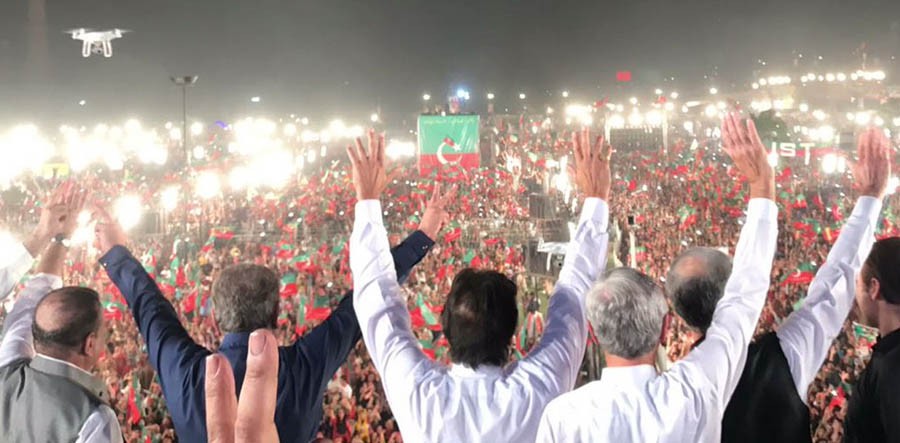
Come election 2018, the real contest will be in Punjab but after Nawaz Sharif’s statements one does not know if PML-N will retain its majority

Pakistan’s major political parties are gearing up for the elections hoping to win majority seats in the national and provincial assemblies to be able to form the next government.
All three parties -- Pakistan Muslim League Nawaz, Pakistan Tehreek-e-Insaf and Pakistan Peoples’ Party -- are confident to form future governments in the provinces where they are ruling presently but also appear optimistic about forming governments in other provinces.
Presently, PML-N, PTI and PPP have governments in the provinces of Punjab, Khyber Pakhtunkhwa and Sindh, respectively. While other parties, such as Muttahida Qaumi Movement, Jamiat Ulema-e-Islam (Fazl) are in opposition in Sindh and KP, respectively.
In general elections 2013, PML-N was number one with 126 seats and 14.9 million votes; PPP was number two with 32 seats and PTI was number three with 28 seats. PTI was the second largest party in terms of number of votes in 2013.
The PTI polled 7.7 million votes and PPP got only 6.9 million. The governments of PML-N and PPP in respective provinces have remained stable in the past five years while PTI faced some turbulence this year because its major ally in KP -- Jamaat-e-Islami -- parted ways in the last month.
Gallup Pakistan survey in April 2018 projected that 34 per cent people said they would vote for PML-N if elections were held today, followed closely by PTI at 26 per cent. While 15 per cent said they would vote for the PPP.
Another survey, by the Pulse Consultant made similar projections with 36 per cent aiming to vote for PML-N, 23 per cent liking PTI, and 15 per cent going with the PPP when asked who they would vote for if elections were held today.
"It is too early to say about projections, particularly, in the Punjab. However, at the moment, nearly half of winning horses, mainly from the ruling PML-N, have defected to PTI while only a few have from central and upper Punjab where we see only four to five defections from PML-N to PTI, which, presently, projects that PMLN still has popularity," says Suhail Warraich, senior journalist.
"If there are more defections from central and upper Punjab in coming days, then PML-N’s strong position will be at risk," adds Warraich.
He believes that in Punjab, which makes more than 50 per cent of the National Assembly, central and upper Punjab will be the main battleground this time with a limited role of independents. "In the present situation, PML-N voter and leadership are in retreat and it is feared that after the caretaker set up there will be further cracks in the party."
He also sees the PPP government in Sindh and fewer than earlier seats for MQM in Sindh. He remains indecisive projecting about PTI in KP.
In the past one year in Sindh, there have been many defections from different parties -- PTI, PML-N, and MQM to PPP, making this long ruling party of the province even stronger. In KP, there are only a few defections from the ruling PTI to other parties. In Balochistan, the PML-N lost its majority because of many defections now united in the form of a new party -- Balochistan Awami Party (BAP), created allegedly by the establishment. While in Punjab, the largest province, there have been more defections from the ruling party to PTI and some to PPP, with fears of more in the next few weeks, which projects a difficult situation for PML-N.
"Defections make PML-N weaker by the day as far as media is concerned. But nothing is decisive now. There is a feeling that heavyweights are leaving PML-N but it is difficult to say whether they are taking PML-N voters along with them. Ultimate verdict is that of voters," says Dr Mohammad Waseem.
"However, despite thinning out of the PML-N, mainly in terms of electoral heavyweights, PTI forming of government in Punjab is less likely." Waseem sees PPP as the third or may be the fourth largest party in the next elections, "PPP cannot make a comeback. However, some kind of an understanding may take place between PPP and PTI in certain areas, may be in Punjab." He thinks "it would be difficult for PTI to retain government in KP in the given circumstances."
"It seems PML-N will lose some seats in Punjab. Representation of PTI is expected to increase in the National Assembly. But it is difficult to say about its quantum. It is possible that no single party gets an absolute majority in the National Assembly," says Dr Hasan Askari Rizvi, senior political analyst.
Read also: The minority factor
He says the real contest will be in Punjab but "after Nawaz Sharif’s latest statements one does not know if PML-N will retain its clear cut majority." In provinces, Rizvi foresees PPP will have greater majority in Sindh while some seats of MQM will go to Pak Sarzameen Party. "While in KP, there is a possibility that PTI retains its government and religious alliance Muttahida Majlis-e-Amal may not be able to get many seats. Individuals will matter in Balochistan."